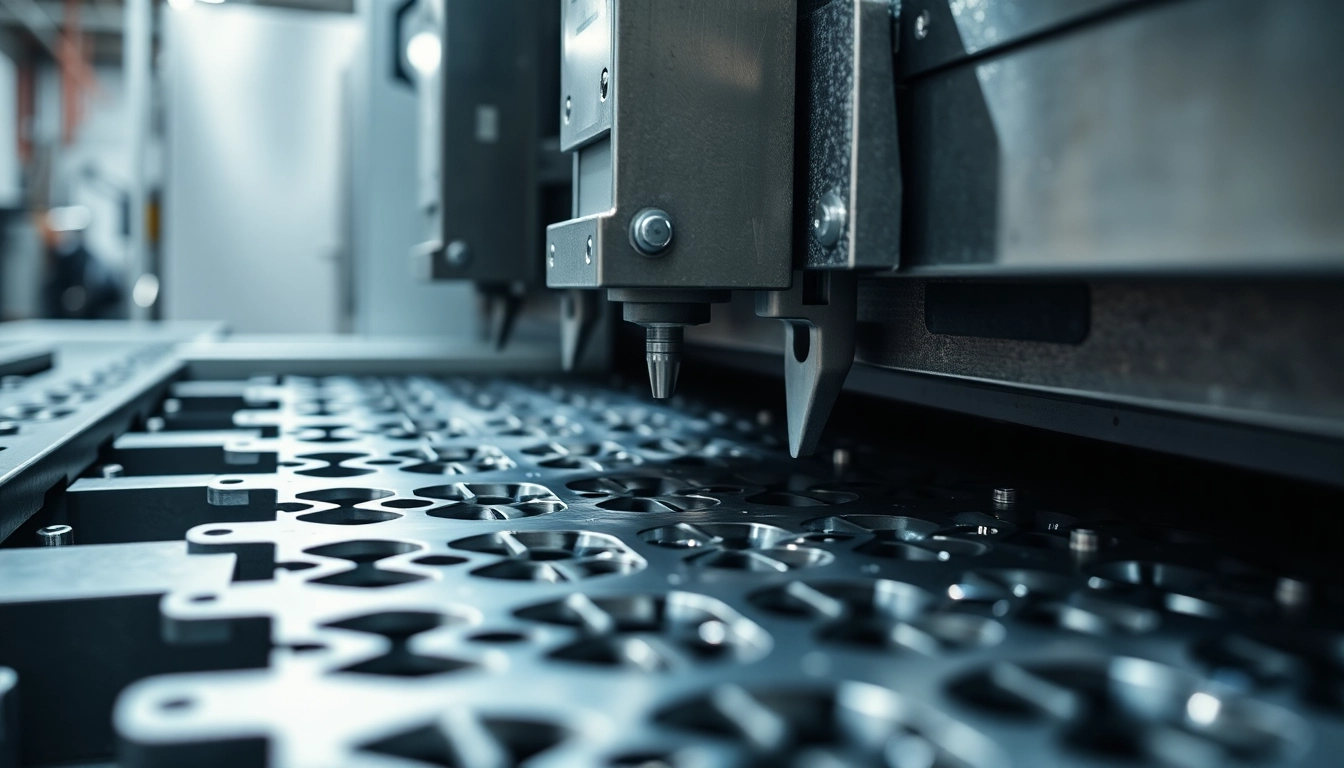Precision Die Cutting Solutions: Elevate Your Production with Accuracy and Efficiency
Understanding Precision Die Cutting
What is Precision Die Cutting?
Precision die cutting is a highly specialized manufacturing process that involves cutting materials with utmost accuracy and consistency to create desired shapes and sizes. This method employs a die—a specialized tool that is shaped according to the specifications of the end product. Precision die cutting is prevalent in various industries, including packaging, automotive, electronics, and medical sectors. The technique allows for both high-volume production and intricate designs with minimal deviation in dimensions.
Applications of Precision Die Cutting Across Industries
The versatility of precision die cutting makes it indispensable across numerous industries:
- Packaging: Used to produce boxes, custom inserts, and labels tailored to specific products.
- Automotive: Vital for creating gaskets, seals, and insulators made of rubber, foam, or plastics.
- Electronics: Utilized for producing components like circuit board insulation and custom shims.
- Medical: Involves crafting parts like wound dressings, surgical tape, and medical device components.
- Textiles: Employed to shape fabric pieces for garments, upholstery, or automotive interiors.
Benefits of Using Precision Die Cutting
The benefits of precision die cutting are manifold, including:
- High Precision: Maintains tight tolerances, often within +/- 0.001 inches, ensuring consistency across batches.
- Cost-Effective: Economically feasible for large-scale production, as the initial tool investment is offset by high-yield rates.
- Enhanced Design Flexibility: Allows for complex shapes and designs that traditional cutting methods cannot achieve.
- Material Efficiency: Minimizes waste through accurate cutting, leading to significant cost savings on raw materials.
- Speed: Facilitates high-speed manufacturing, significantly reducing lead times to market.
The Precision Die Cutting Process Explained
Key Steps in the Die Cutting Process
The die cutting process is systematic and involves several key steps:
- Design Creation: A CAD (computer-aided design) model is created, detailing the specifications and features of the die and finished product.
- Die Making: The die is fabricated based on the design specifications. It can be made from various materials, including steel or brass, depending on the complexity and precision required.
- Material Preparation: The chosen material is prepared, which may involve rolling, sheet cutting, or laying down sheets in bulk.
- Die Cutting: The prepared material is placed under the die in a die-cutting machine, where the die presses down to cut the material into shape.
- Trimming and Finishing: Post-cutting, excess material is removed, and the finished product is inspected for quality assurance.
Types of Die Cutting Techniques
There are primarily two types of die cutting techniques utilized in precision die cutting:
- Flatbed Die Cutting: Utilizes a flat bed to hold the material while a hydraulic press pushes the die down onto it. It is particularly effective for thick materials and intricate designs.
- Rotary Die Cutting: Involves a cylindrical die that rotates to cut the material as it feeds through a machine. This method is best for high-volume production when speed and efficiency are paramount.
Material Selection for Precision Die Cutting
Choosing the right material is critical for the success of precision die cutting. Common materials include:
- Plastics: Versatile and cost-effective, used for packaging and components in electronics.
- Foams: Ideal for cushioning and sealing applications, particularly in automotive and medical industries.
- Metals: Thin sheets of steel or aluminum are cut for applications requiring durability and strength.
- Papers and Cardboards: Perfect for creating packaging solutions and prototypes.
- Rubbers: Commonly used for gaskets and seals in automotive and mechanical applications.
Choosing the Right Precision Die Cutting Service
Factors to Consider When Selecting a Provider
When selecting a precision die cutting service, it’s essential to consider several factors:
- Experience: Look for a provider with a proven track record in your industry or a similar one, as experience often correlates with knowledge and reliability.
- Quality Assurance Processes: Ensure the provider implements rigorous quality control measures to maintain high standards throughout production.
- Technology and Machinery: Assess the technology they use; modern and well-maintained machines can significantly impact the quality and efficiency of die cutting.
- Customer Support: A responsive and knowledgeable customer service team can help address questions and facilitate smoother project execution.
- Pricing Structure: Compare pricing models to find a balance of quality and cost that fits your budget.
Questions to Ask Your Die Cutting Vendor
To ensure you select the most capable vendor, consider asking these critical questions:
- What are your lead times for different types of die cutting?
- Can you provide samples of previous work similar to my project?
- What sort of tolerances can you guarantee on the final product?
- What materials are you able to work with, and do you provide material sourcing?
- What is your capacity for both small and large production runs?
Evaluating Quality and Performance Metrics
Evaluating quality and performance is essential for ensuring that your die cutting needs are met effectively. Key metrics include:
- Dimensional Accuracy: Measure how closely the cut parts meet the specifications laid out in the design.
- Production Yield: The ratio of acceptable finished parts to the total produced should be high, indicating efficient processes.
- Turnaround Time: Timely delivery is crucial for aligning with production schedules.
- Customer Satisfaction: Feedback and satisfaction ratings from past clients can provide insight into the reliability of the provider.
Common Challenges in Precision Die Cutting
Addressing Tolerances and Specifications
Maintaining tight tolerances is a common challenge in precision die cutting. To mitigate this:
- Utilize high-quality dies made from durable materials to reduce wear over time.
- Implement state-of-the-art machinery equipped with advanced monitoring systems for automatic adjustments based on real-time data.
- Conduct regular calibration of machines to ensure they remain within the specified tolerance levels.
Mitigating Production Delays and Errors
Production delays and errors can derail timelines. To combat these issues:
- Create a detailed project timeline from initiation to delivery, including key milestones.
- Build open lines of communication with your service provider to promptly address any arising issues.
- Implement a robust quality control process that checks products at various stages of production to catch errors early.
Maximizing Efficiency in Production Processes
Maximizing efficiency ensures cost-effectiveness and timely delivery:
- Adopt lean manufacturing techniques to eliminate waste in production processes.
- Invest in automation where feasible to streamline repetitive tasks.
- Train staff on advanced manufacturing practices to empower them to contribute to efficiency improvements.
Future Trends in Precision Die Cutting Technology
Advancements in Die Cutting Machinery
The advent of new technologies is paving the way for advancements in die cutting machinery, leading to:
- Increased Automation: Automated die cutting machines are becoming more prevalent, reducing human error and production times.
- Smart Technology: Integration of IoT (Internet of Things) in machines allows for real-time data collection and monitoring, enhancing predictive maintenance.
- Sophisticated CAD Solutions: Modern CAD software facilitates better design integration and simulation, improving the overall design process.
The Role of Automation and Digital Technologies
Automation and digital technologies are set to redefine the precision die cutting landscape:
- Digital die cutting allows for quick adjustments to designs without the need for new dies, promoting rapid prototyping.
- Advanced data analytics can help manufacturers identify inefficiencies in their processes, leading to significant improvements in productivity.
- 3D printing is complementing die cutting by providing intricate designs and very short runs, extending capabilities beyond traditional limitations.
Sustainability Practices in Precision Die Cutting
As eco-friendliness becomes increasingly crucial, sustainability practices in precision die cutting gain importance:
- Utilizing recycled or biodegradable materials can greatly reduce environmental impact.
- Implementing efficient waste management systems ensures that scrap materials are minimized and recycled.
- Transitioning to energy-efficient machinery can also reduce the carbon footprint of production processes.



